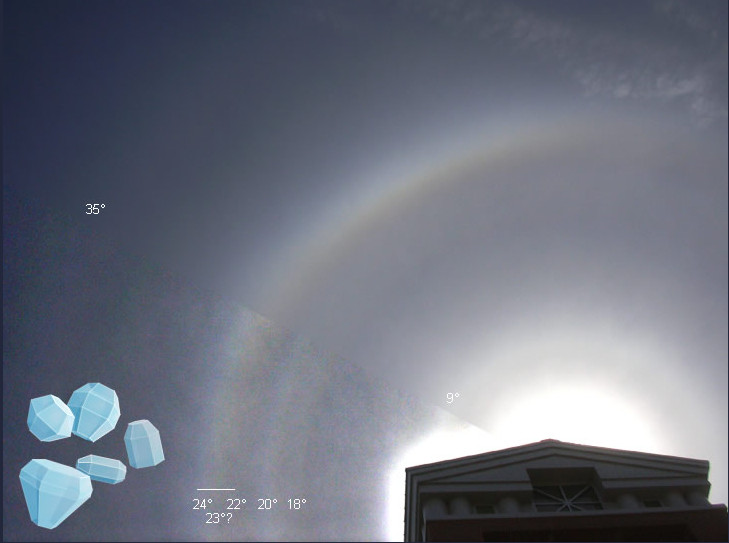Odd Radius Halos
Odd Radius Halos: A Rare and Captivating Atmospheric Phenomenon
Have you ever witnessed a mesmerizing display of odd radius halos in the sky? These enchanting optical phenomena occur when sunlight interacts with six-sided pyramidal ice crystals suspended in the atmosphere. Rays of light passing through these crystals enter and exit through faces with varying inclinations to each other, resulting in circular halos of multiple radii. While halos with even radii are more commonly observed, odd radius halos are a rare and captivating sight that leaves spectators in awe.
The intricate formation of odd radius halos creates a visually stunning spectacle. These halos exhibit a complete set of radii, including the exceptionally rare outer 35° halo. Typically, halo formations are transient and elusive, appearing and disappearing within moments. However, the 35° halo described by Russell Sampson, an observer from Eastern Connecticut State University, was both persistent and visually discernible for an extended period of time. This unique characteristic adds to the fascination surrounding odd radius halos.
The pyramidal ice crystals responsible for these captivating halos are an intriguing subject of study. These crystals have a distinctive six-sided shape, resembling miniature pyramids. As sunlight enters these crystals, it undergoes a process of refraction and reflection, resulting in the formation of halos. The intricate internal structure of the pyramidal crystals plays a crucial role in determining the radii and characteristics of the halos observed.
While odd radius halos are relatively rare compared to their even radius counterparts, they are not entirely uncommon. However, their appearance is highly dependent on specific atmospheric conditions that favor the formation of pyramidal ice crystals. These conditions include temperatures conducive to the growth of ice crystals, as well as the presence of high-altitude cirrus clouds where these crystals can be suspended.
To fully appreciate the captivating beauty of odd radius halos, observers often enhance the contrast and apply unsharp masking techniques to their photographs. These post-processing methods help to bring out the intricate details and highlight the distinct radii of the halos. By employing these techniques, photographers and enthusiasts can capture the essence of this atmospheric phenomenon and share its enchantment with others.
Odd radius halos serve as a reminder of the intricate and awe-inspiring wonders that exist within our atmosphere. Their presence ignites curiosity and encourages further exploration of atmospheric optics. Scientists and researchers continue to study the formation and characteristics of these halos, striving to unravel the complexities of their creation. Through their efforts, we gain a deeper understanding of the atmospheric conditions that give rise to these captivating displays.
In conclusion, odd radius halos are a rare and captivating atmospheric phenomenon that showcases the beauty and complexity of nature. These halos, formed by six-sided pyramidal ice crystals, create circular patterns of various radii when sunlight interacts with them. While odd radius halos are less frequently observed than their even radius counterparts, they leave a lasting impression on those fortunate enough to witness them. Through ongoing research and exploration, we continue to unravel the secrets behind these captivating displays, deepening our understanding of atmospheric optics and the wonders that lie above us.

Odd Radius Halos seen by Russell Sampson at Eastern Connecticut State University, Willimantic, CT on April 10, '08. The sun is hidden behind the library building. ©Russell Sampson, shown with permission.
Six sided pyramidal ice crystals make the halos. Rays passing through them enter and leave through faces with a number of different inclinations to each other resulting in circular halos of many different radii.
This rare display has an unusually complete set including the rare outer 35° halo - “The 35 was persistent and visual (i.e. I could see it and it stayed in the same place over many minutes) so I’m confident it is not spurious.”
The lower sector is contrast enhanced and unsharp masked.
Odd radius halos
Pyramidal crystals
Note: this article has been automatically converted from the old site and may not appear as intended. You can find the original article here.
Reference Atmospheric Optics
If you use any of the definitions, information, or data presented on Atmospheric Optics, please copy the link or reference below to properly credit us as the reference source. Thank you!
-
<a href="https://atoptics.co.uk/blog/odd-radius-halos/">Odd Radius Halos</a>
-
"Odd Radius Halos". Atmospheric Optics. Accessed on December 22, 2024. https://atoptics.co.uk/blog/odd-radius-halos/.
-
"Odd Radius Halos". Atmospheric Optics, https://atoptics.co.uk/blog/odd-radius-halos/. Accessed 22 December, 2024
-
Odd Radius Halos. Atmospheric Optics. Retrieved from https://atoptics.co.uk/blog/odd-radius-halos/.